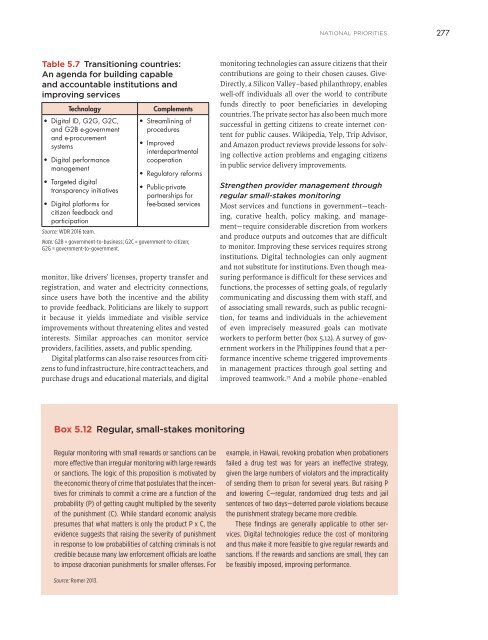Authorized Authorized
eERqs
eERqs
Create successful ePaper yourself
Turn your PDF publications into a flip-book with our unique Google optimized e-Paper software.
NATIONAL PRIORITIES<br />
277<br />
Table 5.7 Transitioning countries:<br />
An agenda for building capable<br />
and accountable institutions and<br />
improving services<br />
Technology<br />
• Digital ID, G2G, G2C,<br />
and G2B e-government<br />
and e-procurement<br />
systems<br />
• Digital performance<br />
management<br />
• Targeted digital<br />
transparency initiatives<br />
• Digital platforms for<br />
citizen feedback and<br />
participation<br />
Source: WDR 2016 team.<br />
Complements<br />
• Streamlining of<br />
procedures<br />
• Improved<br />
interdepartmental<br />
cooperation<br />
• Regulatory reforms<br />
• Public-private<br />
partnerships for<br />
fee-based services<br />
Note: G2B = government-to-business; G2C = government-to-citizen;<br />
G2G = government-to-government.<br />
monitor, like drivers’ licenses, property transfer and<br />
registration, and water and electricity connections,<br />
since users have both the incentive and the ability<br />
to provide feedback. Politicians are likely to support<br />
it because it yields immediate and visible service<br />
improvements without threatening elites and vested<br />
interests. Similar approaches can monitor service<br />
providers, facilities, assets, and public spending.<br />
Digital platforms can also raise resources from citizens<br />
to fund infrastructure, hire contract teachers, and<br />
purchase drugs and educational materials, and digital<br />
monitoring technologies can assure citizens that their<br />
contributions are going to their chosen causes. Give-<br />
Directly, a Silicon Valley–based philanthropy, enables<br />
well-off individuals all over the world to contribute<br />
funds directly to poor beneficiaries in developing<br />
countries. The private sector has also been much more<br />
successful in getting citizens to create internet content<br />
for public causes. Wikipedia, Yelp, Trip Advisor,<br />
and Amazon product reviews provide lessons for solving<br />
collective action problems and engaging citizens<br />
in public service delivery improvements.<br />
Strengthen provider management through<br />
regular small-stakes monitoring<br />
Most services and functions in government—teaching,<br />
curative health, policy making, and management—require<br />
considerable discretion from workers<br />
and produce outputs and outcomes that are difficult<br />
to monitor. Improving these services requires strong<br />
institutions. Digital technologies can only augment<br />
and not substitute for institutions. Even though measuring<br />
performance is difficult for these services and<br />
functions, the processes of setting goals, of regularly<br />
communicating and discussing them with staff, and<br />
of associating small rewards, such as public recognition,<br />
for teams and individuals in the achievement<br />
of even imprecisely measured goals can motivate<br />
workers to perform better (box 5.12). A survey of government<br />
workers in the Philippines found that a performance<br />
incentive scheme triggered improvements<br />
in management practices through goal setting and<br />
improved teamwork. 75 And a mobile phone–enabled<br />
Box 5.12 Regular, small-stakes monitoring<br />
Regular monitoring with small rewards or sanctions can be<br />
more effective than irregular monitoring with large rewards<br />
or sanctions. The logic of this proposition is motivated by<br />
the economic theory of crime that postulates that the incentives<br />
for criminals to commit a crime are a function of the<br />
probability (P) of getting caught multiplied by the severity<br />
of the punishment (C). While standard economic analysis<br />
presumes that what matters is only the product P x C, the<br />
evidence suggests that raising the severity of punishment<br />
in response to low probabilities of catching criminals is not<br />
credible because many law enforcement officials are loathe<br />
to impose draconian punishments for smaller offenses. For<br />
example, in Hawaii, revoking probation when probationers<br />
failed a drug test was for years an ineffective strategy,<br />
given the large numbers of violators and the impracticality<br />
of sending them to prison for several years. But raising P<br />
and lowering C—regular, randomized drug tests and jail<br />
sentences of two days—deterred parole violations because<br />
the punishment strategy became more credible.<br />
These findings are generally applicable to other services.<br />
Digital technologies reduce the cost of monitoring<br />
and thus make it more feasible to give regular rewards and<br />
sanctions. If the rewards and sanctions are small, they can<br />
be feasibly imposed, improving performance.<br />
Source: Romer 2013.


